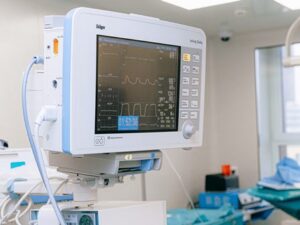Cardiac output measurement important measure of cardiac performance. It measures the volume of blood pumped into the circulatory system by the heart per min. Cardiac output related to blood pressure. Several methods used for determining cardiac output. The method used by L&T patient monitoring system is the thermodilution method. With thermodilution, cardiac output measured as the liters of blood pumped per minute into the pulmonary artery by the right ventricle of the Heart.
Breath
Rise and fall in the carbon-dioxide concentration of at least one percent
carbon-dioxide is no less than 0.4 seconds
One inhalation + One exhalation = One Breath.
Respiratory Rate (RR)
Number of Breaths per Min.
End-Tidal Carbon dioxide (EtCO2)
The level of 002 in the airway at the end of expiration. In L&T’s Capnography one breath with the sampling interval, therefore monitor will report the 002 level at the end-respiration point of each breath.
Fractional Inspired Carbon-dioxide
The amount of CO2 inspired during inspiration i.e rebreathing of C02.
Following accessories are provided for Capnography along with the monitor.
Neonate
Concepts Cardiac output is determined by heart rate and stroke volume, as defined below.
Heart rate
The number of times heartbeats in one minute.
Stroke volume
The amount of blood pumped per beat. Cardiac index
A measure of individual cardiac output adequacy, calculated by dividing the cardiac output by the body surface area.
Measurement Principle
The thermodilution method based on the principle that the flow rate of an unknown quantity of liquid can be determined by adding a known quantity of indicator and measuring its concentration downstream. Thermodilution involves injecting an ice-cold solution at known temperature into the heart. The injected solution mixes and cools the surrounding blood. When the blood leaves the heat, its temperature as a function of time indicates the rate of blood flow.
Measurement Acquisition
The measurement takes with a pulmonary artery catheter (PAC).
The catheter inserted into the heart, with the proximal lumen opening positioned in the right atrium for introducing the injectate, and the thermistor, used for monitoring temperature, positioned in the pulmonary artery. Pressure measurements and X-rays of the Catheter location gauge positioning of the Catheter. A small amount of thermal indicator introduced into the right atrium, the indicator mixes with the right ventricle and approaches temperature equilibrium. When the diluted blood reaches the Pulmonary artery, the thermistor measures the decrease in blood temperature over time.
On measuring the temperature of the cooling bath in which the injectate kept, the temperature of the injected solution can be measured.
Cardiac Output
The time/temperature curve resulting from the measurement resembles a bell-shaped curve, except that it has an exponential decay. The data integrated into a calculated area beneath the curve. By convention, the Y-axis of the graph shows decreasing temperature.
Criteria for proper Measurement Factors affecting the accurate measurement of cardiac output include:
Physiology conditions: Variation in cardiac rate rhythm, cardiac abnormalities or patient anxiety .or movement can
cause errors in measurement. Catheter conditions: A damaged or incorrectly positioned catheter, or prematurely inflated balloon will cause measurement errors.
Inaccurate timing. Volume, or temperature of injectate, as well as the use of the wrong catheter port, will result in errors.
CO Maintenance schedule
Catheters are disposable and single-use only.
Check the accessories before use.
Do not attempt to sterilize the accessories. Use specified accessories only. CO & IT Probe are not auto cleavable. It should be washed through with CIDEX solution
